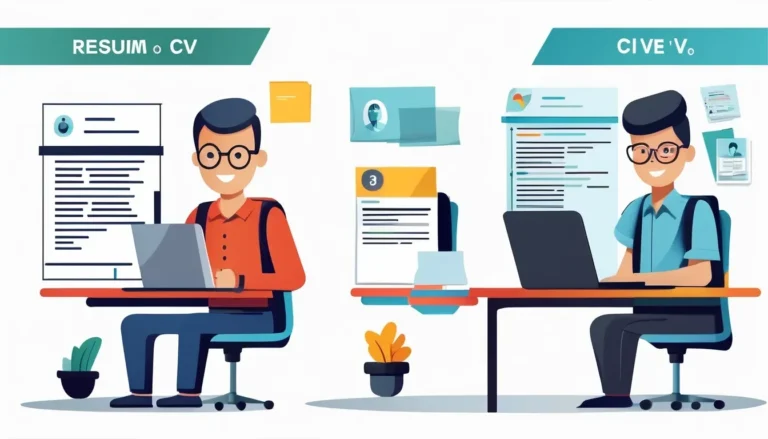When it comes to job applications, one of the most common questions is: “Do I need a resume or a CV?” While these two documents serve similar purposes—presenting your qualifications to potential employers—they are not the same. Whether you’re a fresh graduate or a seasoned professional, understanding the difference between a resume and a CV (Curriculum Vitae) is crucial for your job search success. In this article, we’ll dive deep into what each document entails, when to use them, and how to make each one shine.
What is a Resume?
A resume is a concise document that summarizes your work experience, skills, education, and accomplishments. Typically, it is limited to 1-2 pages and is highly targeted to the specific role or industry you’re applying for. The word “resume” comes from the French term meaning “summary,” and that’s exactly what this document should be—a brief overview of your career highlights that are most relevant to the job.
Key Features of a Resume:
- Length: 1-2 pages maximum.
- Structure: A well-structured resume includes your contact information, a professional summary, work experience, skills, and education.
- Customization: Resumes are tailored for each job you apply to, highlighting only the experiences and skills that directly relate to the position.
- Focus: A resume emphasizes practical, professional experience and results-driven achievements.
- Objective or Summary: Many resumes include a short “Objective” or “Professional Summary” section at the top, giving recruiters a quick snapshot of who you are and what you’re looking for.
Think of your resume as a sales pitch. It’s designed to grab the employer’s attention quickly and make them want to learn more about you in an interview.
What is a CV (Curriculum Vitae)?
A CV, short for Curriculum Vitae, is a more detailed document that provides a comprehensive overview of your academic and professional achievements. In Latin, “curriculum vitae” means “course of life,” and true to its name, a CV provides an in-depth look at your career path, including education, research, publications, presentations, and other accomplishments.
Unlike a resume, a CV can be as long as it needs to be, sometimes stretching to 3 pages or more depending on the individual’s experience. CVs are typically used in academia, research, medical professions, and sometimes in international job markets.
Key Features of a CV:
- Length: Often 2-4 pages, but there’s no strict limit.
- Structure: A CV includes sections such as education, research experience, publications, academic presentations, grants, awards, and professional affiliations.
- Content: It focuses more on academic achievements and contributions to the field rather than work experience.
- Static: Unlike resumes, CVs are often not customized for each job but are updated as you gain new qualifications or experience.
- Usage: CVs are commonly used for academic roles (professors, researchers, etc.), medical careers, and international jobs.
In summary, a CV is your entire professional history laid out in detail, whereas a resume is a targeted snapshot of your most relevant experiences.
When to Use a Resume vs. a CV
Knowing when to use a resume and when to use a CV is essential. Here’s a quick guide to help you determine which document is appropriate:
Use a Resume If:
- You’re applying for a private sector job in industries like business, marketing, tech, finance, or other non-academic fields.
- The job posting specifically requests a resume.
- You want to provide a focused and succinct overview of your professional experience.
- You’re applying in countries like the U.S., Canada, or Australia, where resumes are more commonly used for job applications.
Use a CV If:
- You’re applying for academic positions, research roles, fellowships, or medical jobs.
- You need to detail your publications, academic presentations, or research contributions.
- The job is in a country that typically requires CVs (many European countries, for example).
- The job application specifically asks for a CV.
- You want to showcase your complete career history, including educational milestones and other long-term achievements.
How to Craft an Outstanding Resume
Creating a great resume is about striking a balance between being comprehensive and concise. Here’s how you can craft an impactful resume that stands out:
- Keep It Relevant: Only include experiences and skills that are directly related to the job you’re applying for. Tailor each resume to the specific position.
- Action-Oriented Language: Use strong action verbs like “managed,” “developed,” or “led” to describe your responsibilities and achievements. Quantify accomplishments where possible (e.g., “Increased sales by 30%”).
- Professional Summary: Start with a compelling professional summary that highlights your strengths and career goals in a nutshell.
- Highlight Key Achievements: Employers want to see results. Focus on accomplishments, such as projects you’ve completed or targets you’ve met, rather than just listing your duties.
- Formatting Matters: Keep the layout clean and easy to read. Stick to simple fonts and use bullet points to make your resume skimmable for recruiters.
How to Build a Compelling CV
If you’re applying for an academic or research role, your CV should reflect the depth of your experience and qualifications. Here’s how to build a comprehensive CV:
- Include Academic Achievements: List your degrees, honors, and research projects, along with any relevant coursework. For roles in academia, your education is a key component of your qualifications.
- Detail Research and Publications: If you’ve published papers, delivered presentations at conferences, or contributed to research, include these in separate sections.
- Professional Affiliations: Mention any memberships in professional organizations or affiliations with academic institutions.
- Grants and Awards: Highlight grants, scholarships, or awards that demonstrate your expertise and recognition in your field.
- Update Regularly: CVs are meant to be dynamic, growing as you achieve more in your career. Keep yours updated with the latest accomplishments.
ATS-Friendly Resumes and Web Portfolios for Students
For students and recent graduates, standing out in a competitive job market can be challenging. That’s why I provide specialized services to create ATS (Applicant Tracking System)-friendly resumes and web portfolios. ATS-friendly resumes are optimized to ensure your resume makes it through the initial automated screening used by many employers. Having a web portfolio is an excellent way to showcase your projects, skills, and experiences, offering potential employers a more dynamic view of your abilities.
Whether you’re applying for internships or your first full-time job, having a professionally crafted resume and an interactive web portfolio can significantly improve your chances of getting noticed by recruiters.
Regional Differences in Resume vs. CV Usage
The difference between a resume and a CV also depends on where you’re applying for jobs. Here’s how the usage of these documents varies by region:
- United States/Canada: Resumes are most commonly used in the private sector, while CVs are reserved for academic and medical professions.
- Europe: In many European countries, the term CV is used even for what Americans might call a resume. However, the CV is still typically shorter for private sector jobs and more detailed for academic roles.
- Australia/New Zealand: The terms resume and CV are often used interchangeably, though resumes are generally shorter and CVs longer.
Conclusion: Which One Do You Need?
To summarize:
- Use a Resume: When you’re applying for jobs in the private sector that emphasize practical experience and results. A resume is your best bet for jobs in marketing, tech, finance, and other industries.
- Use a CV: When applying for academic, medical, or research-based roles, or when you’re applying for jobs in countries where a CV is the norm. A CV is the right choice if you need to showcase your academic achievements and comprehensive career history.
In today’s competitive job market, knowing when to use a resume versus a CV can make a big difference. By choosing the right document and tailoring it to your desired role, you can improve your chances of landing your next job.





